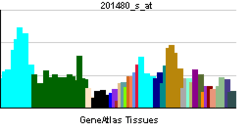SUPT5H
Transcription elongation factor SPT5 is a protein that in humans is encoded by the SUPT5H gene.[1][2]
Interactions
SUPT5H has been shown to interact with Cyclin-dependent kinase 7,[3] PIN1,[4] CDK9,[3] HTATSF1,[5] POLR2A,[5][6] PRMT1[7] and Protein arginine methyltransferase 5.[7]
References
- ↑ Chiang PW, Fogel E, Jackson CL, Lieuallen K, Lennon G, Qu X, Wang SQ, Kurnit DM (March 1997). "Isolation, sequencing, and mapping of the human homologue of the yeast transcription factor, SPT5". Genomics 38 (3): 421–4. doi:10.1006/geno.1996.0646. PMID 8975720.
- ↑ "Entrez Gene: SUPT5H Suppressor of Ty 5 homolog (S. cerevisiae)".
- ↑ 3.0 3.1 Garber, M E; Mayall T P; Suess E M; Meisenhelder J; Thompson N E; Jones K A (September 2000). "CDK9 autophosphorylation regulates high-affinity binding of the human immunodeficiency virus type 1 tat-P-TEFb complex to TAR RNA". Mol. Cell. Biol. (UNITED STATES) 20 (18): 6958–69. doi:10.1128/MCB.20.18.6958-6969.2000. ISSN 0270-7306. PMC 88771. PMID 10958691.
- ↑ Lavoie, S B; Albert A L; Handa H; Vincent M; Bensaude O (September 2001). "The peptidyl-prolyl isomerase Pin1 interacts with hSpt5 phosphorylated by Cdk9". J. Mol. Biol. (England) 312 (4): 675–85. doi:10.1006/jmbi.2001.4991. ISSN 0022-2836. PMID 11575923.
- ↑ 5.0 5.1 Kim, J B; Yamaguchi Y; Wada T; Handa H; Sharp P A (September 1999). "Tat-SF1 protein associates with RAP30 and human SPT5 proteins". Mol. Cell. Biol. (UNITED STATES) 19 (9): 5960–8. ISSN 0270-7306. PMC 84462. PMID 10454543.
- ↑ Wada, T; Takagi T, Yamaguchi Y, Ferdous A, Imai T, Hirose S, Sugimoto S, Yano K, Hartzog G A, Winston F, Buratowski S, Handa H (February 1998). "DSIF, a novel transcription elongation factor that regulates RNA polymerase II processivity, is composed of human Spt4 and Spt5 homologs". Genes Dev. (UNITED STATES) 12 (3): 343–56. doi:10.1101/gad.12.3.343. ISSN 0890-9369. PMC 316480. PMID 9450929.
- ↑ 7.0 7.1 Kwak, Youn Tae; Guo Jun; Prajapati Shashi; Park Kyu-Jin; Surabhi Rama M; Miller Brady; Gehrig Peter; Gaynor Richard B (April 2003). "Methylation of SPT5 regulates its interaction with RNA polymerase II and transcriptional elongation properties". Mol. Cell (United States) 11 (4): 1055–66. doi:10.1016/S1097-2765(03)00101-1. ISSN 1097-2765. PMID 12718890.
Further reading
- Andersson B, Wentland MA, Ricafrente JY et al. (1996). "A "double adaptor" method for improved shotgun library construction.". Anal. Biochem. 236 (1): 107–13. doi:10.1006/abio.1996.0138. PMID 8619474.
- Yu W, Andersson B, Worley KC et al. (1997). "Large-scale concatenation cDNA sequencing.". Genome Res. 7 (4): 353–8. doi:10.1101/gr.7.4.353. PMC 139146. PMID 9110174.
- Stachora AA, Schäfer RE, Pohlmeier M et al. (1997). "Human Supt5h protein, a putative modulator of chromatin structure, is reversibly phosphorylated in mitosis.". FEBS Lett. 409 (1): 74–8. doi:10.1016/S0014-5793(97)00486-9. PMID 9199507.
- Wada T, Takagi T, Yamaguchi Y et al. (1998). "DSIF, a novel transcription elongation factor that regulates RNA polymerase II processivity, is composed of human Spt4 and Spt5 homologs.". Genes Dev. 12 (3): 343–56. doi:10.1101/gad.12.3.343. PMC 316480. PMID 9450929.
- Wu-Baer F, Lane WS, Gaynor RB (1998). "Role of the human homolog of the yeast transcription factor SPT5 in HIV-1 Tat-activation.". J. Mol. Biol. 277 (2): 179–97. doi:10.1006/jmbi.1997.1601. PMID 9514752.
- Wada T, Takagi T, Yamaguchi Y et al. (1999). "Evidence that P-TEFb alleviates the negative effect of DSIF on RNA polymerase II-dependent transcription in vitro.". EMBO J. 17 (24): 7395–403. doi:10.1093/emboj/17.24.7395. PMC 1171084. PMID 9857195.
- Yamaguchi Y, Wada T, Watanabe D et al. (1999). "Structure and function of the human transcription elongation factor DSIF.". J. Biol. Chem. 274 (12): 8085–92. doi:10.1074/jbc.274.12.8085. PMID 10075709.
- Yamaguchi Y, Takagi T, Wada T et al. (1999). "NELF, a multisubunit complex containing RD, cooperates with DSIF to repress RNA polymerase II elongation.". Cell 97 (1): 41–51. doi:10.1016/S0092-8674(00)80713-8. PMID 10199401.
- Parada CA, Roeder RG (1999). "A novel RNA polymerase II-containing complex potentiates Tat-enhanced HIV-1 transcription.". EMBO J. 18 (13): 3688–701. doi:10.1093/emboj/18.13.3688. PMC 1171446. PMID 10393184.
- Wen Y, Shatkin AJ (1999). "Transcription elongation factor hSPT5 stimulates mRNA capping.". Genes Dev. 13 (14): 1774–9. doi:10.1101/gad.13.14.1774. PMC 316881. PMID 10421630.
- Kim JB, Yamaguchi Y, Wada T et al. (1999). "Tat-SF1 protein associates with RAP30 and human SPT5 proteins.". Mol. Cell. Biol. 19 (9): 5960–8. PMC 84462. PMID 10454543.
- Ivanov D, Kwak YT, Guo J, Gaynor RB (2000). "Domains in the SPT5 protein that modulate its transcriptional regulatory properties.". Mol. Cell. Biol. 20 (9): 2970–83. doi:10.1128/MCB.20.9.2970-2983.2000. PMC 85557. PMID 10757782.
- Wada T, Orphanides G, Hasegawa J et al. (2000). "FACT relieves DSIF/NELF-mediated inhibition of transcriptional elongation and reveals functional differences between P-TEFb and TFIIH.". Mol. Cell 5 (6): 1067–72. doi:10.1016/S1097-2765(00)80272-5. PMID 10912001.
- Ping YH, Rana TM (2001). "DSIF and NELF interact with RNA polymerase II elongation complex and HIV-1 Tat stimulates P-TEFb-mediated phosphorylation of RNA polymerase II and DSIF during transcription elongation.". J. Biol. Chem. 276 (16): 12951–8. doi:10.1074/jbc.M006130200. PMID 11112772.
- Kim JB, Sharp PA (2001). "Positive transcription elongation factor B phosphorylates hSPT5 and RNA polymerase II carboxyl-terminal domain independently of cyclin-dependent kinase-activating kinase.". J. Biol. Chem. 276 (15): 12317–23. doi:10.1074/jbc.M010908200. PMID 11145967.
- Renner DB, Yamaguchi Y, Wada T et al. (2001). "A highly purified RNA polymerase II elongation control system.". J. Biol. Chem. 276 (45): 42601–9. doi:10.1074/jbc.M104967200. PMID 11553615.
- Lavoie SB, Albert AL, Handa H et al. (2001). "The peptidyl-prolyl isomerase Pin1 interacts with hSpt5 phosphorylated by Cdk9.". J. Mol. Biol. 312 (4): 675–85. doi:10.1006/jmbi.2001.4991. PMID 11575923.
- Bourgeois CF, Kim YK, Churcher MJ et al. (2002). "Spt5 cooperates with human immunodeficiency virus type 1 Tat by preventing premature RNA release at terminator sequences.". Mol. Cell. Biol. 22 (4): 1079–93. doi:10.1128/MCB.22.4.1079-1093.2002. PMC 134635. PMID 11809800.
- Yamaguchi Y, Inukai N, Narita T et al. (2002). "Evidence that negative elongation factor represses transcription elongation through binding to a DRB sensitivity-inducing factor/RNA polymerase II complex and RNA.". Mol. Cell. Biol. 22 (9): 2918–27. doi:10.1128/MCB.22.9.2918-2927.2002. PMC 133766. PMID 11940650.
| |||||||||


